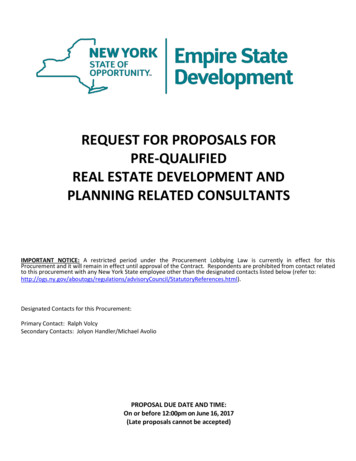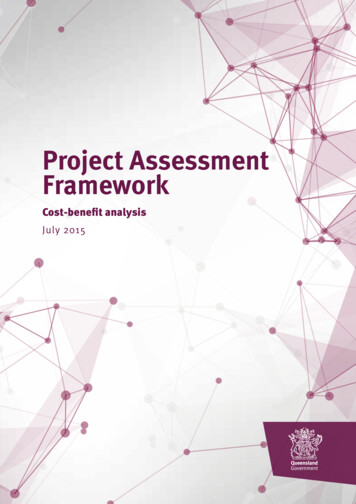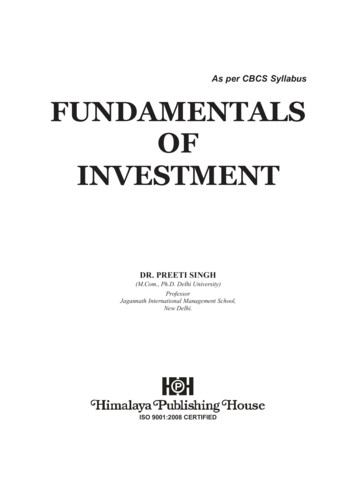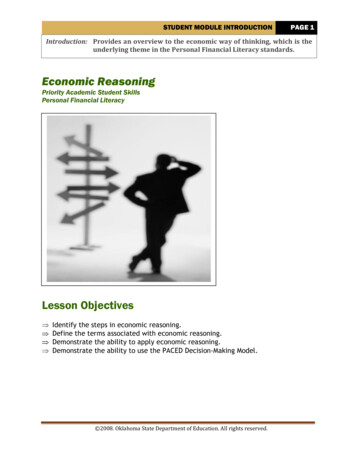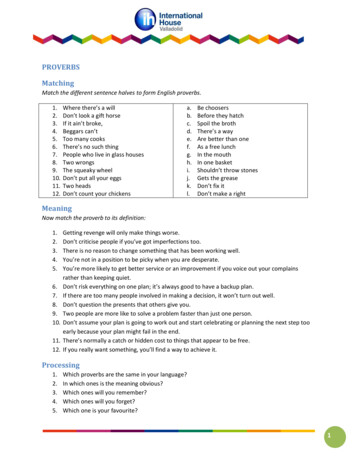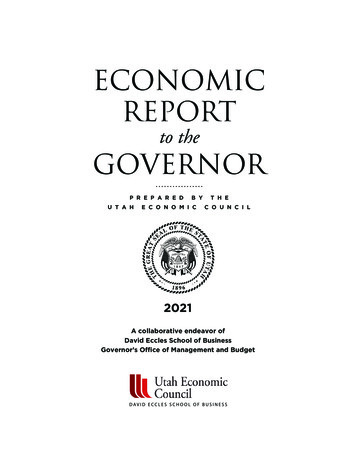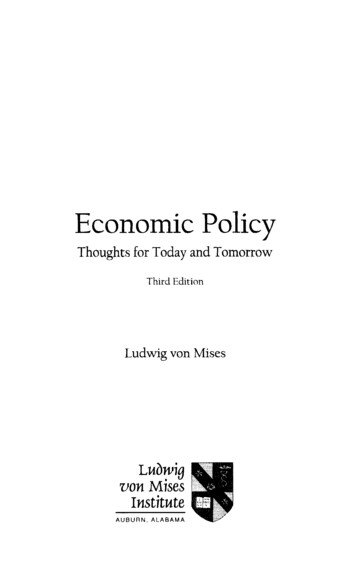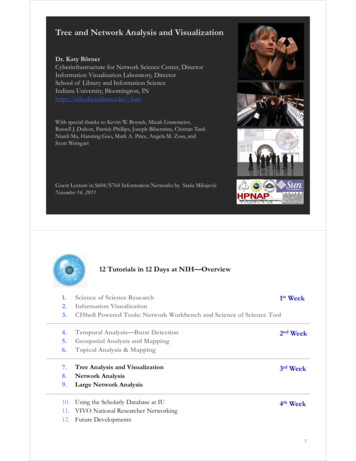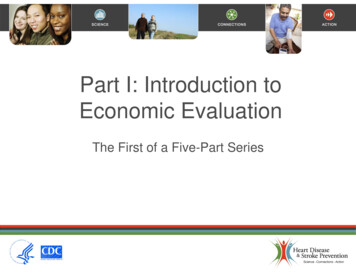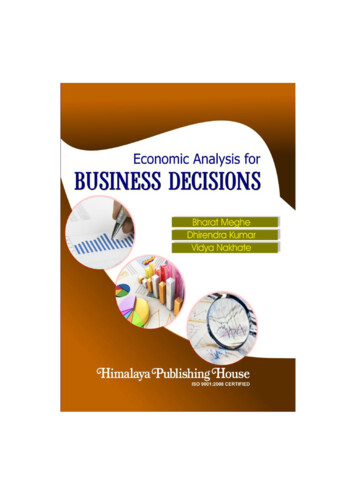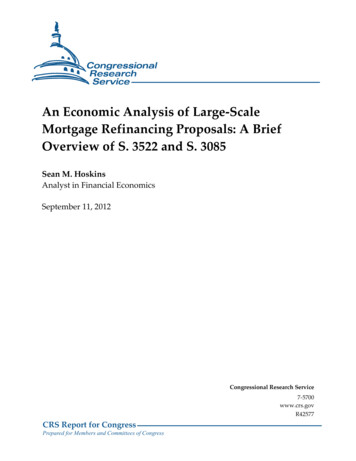
Transcription
An Economic Analysis of Large-ScaleMortgage Refinancing Proposals: A BriefOverview of S. 3522 and S. 3085Sean M. HoskinsAnalyst in Financial EconomicsSeptember 11, 2012Congressional Research Service7-5700www.crs.govR42577CRS Report for CongressPrepared for Members and Committees of Congress
An Economic Analysis of Large-Scale Mortgage Refinancing Proposals: A Brief OverviewThe bursting of the housing bubble in 2006 precipitated the December 2007-June 2009recession and a financial panic in September 2008. With the housing market seen as alocus for many of the economic problems that emerged, some Members of Congresspropose intervening in the housing market as a means of improving not only the housing marketitself but also the financial sector and the broader economy. Critics are concerned that furtherintervention could prolong the housing slump, delay recovery, and affect outcomes based on thegovernment’s preferences rather than market forces.This report provides a brief overview of policy proposals for the large-scale refinancing ofmortgages for borrowers shut out of traditional financing methods. An expansion of this reportappears in CRS Report R42480, Reduce, Refinance, and Rent? The Economic Incentives, Risks,and Ramifications of Housing Market Policy Options, by Sean M. Hoskins. Contained in thatreport is longer, in-depth analysis of large-scale refinance and two other frequently discussedpolicy options, reducing mortgage principal for borrowers who owe more than their homes areworth and renting out foreclosed homes.OverviewWith mortgage rates at historic lows, somehave proposed expanding an existing largescale refinancing program, the HomeAffordable Refinance Program (HARP),2 toallow more borrowers to take advantage oflow rates. When first introduced in February2009, the Obama Administration originallyestimated that HARP would aid between 4million and 5 million borrowers.Approximately 1.54 million mortgages havebeen refinanced through HARP as of July2012.3Example of a Mortgage Refinance A borrower took out a 200,000 mortgage in 2006with a 6.5% fixed interest rate to be paid over 30years. The borrower’s monthly payments are about 1,264. Part of each monthly payment pays down theprincipal and the interest. In 2012, the outstandingbalance is 184,396. By refinancing the remaining 184,396 into a new 30year loan with a 4% interest rate, the new monthlypayments are 880. To refinance, the borrower must pay closing costs,which are estimated to be 3% of the outstandingbalance, approximately 5,500- 6,000 in thisexample.1In a refinance, a borrower takes out a newhome loan and uses it to pay off the previous The borrower lowers the monthly payment by 384loan, usually with more favorable terms such( 1,264 - 880 384) and saves over 48,000as a reduced monthly payment. A borrowerover the life of the loan.can refinance with their original lender or withExample created by author.a new lender. HARP allows some borrowerswho are current on their mortgage but havelittle or no equity in their home to refinance into a new mortgage with a lower interest rate if their1For more on closing costs, see The Federal Reserve Board, A Consumer’s Guide to Mortgage Refinancings, 2For more on HARP, see CRS Report R40210, Preserving Homeownership: Foreclosure Prevention Initiatives, byKatie Jones. HARP is not the only government refinance program. FHA also established the FHA StreamlineRefinance Program. However, HARP is the largest of the refinance programs and the subject of several congressionalproposals.3See Federal Housing Finance Agency, Refinance Report July 2012, at http://www.fhfa.gov/webfiles/24274/Jul12 Refi Report.pdf.Congressional Research Service1
An Economic Analysis of Large-Scale Mortgage Refinancing Proposals: A Brief Overviewmortgage is held by Fannie Mae or Freddie Mac (the government-sponsored enterprises orGSEs). As of April 2012, more than 23% of mortgagors had negative equity, owing more thantheir home was worth.4The legislative proposals discussed below aimto expand HARP to aid more borrowers withGSE mortgages that are unable to refinanceMortgage interest rates are one of the major factors thatthrough traditional methods. In particular,influence a borrower’s decision to refinance. Wheninterest rates fall, refinances typically increase.HARP attempts to help borrowers refinanceBorrowers will not refinance every time interest rateswho have little or no equity. If a borrower hasfall because there are fixed costs to refinancing. Alittle or no equity in the home and houseborrower may save a little each month from having aprices fall, then should the borrower default,lower interest rate, but it is only worthwhile to refinanceif the amount saved in the first few years is greater thanthe financial institution could not recover thethe closing cost for refinancing. A typical estimate is thatfull value of its loan by selling the house.interest rates have to fall by 1 to 2 percentage pointsLenders traditionally require borrowers tobelow a borrower’s existing rate for it to be in thehave at least 20% positive equity in theirborrower’s best interest to refinance.5home to refinance. If a borrower’s home isvalued at 200,000 and the borrower owes 160,000 or less on the mortgage (loan-to-value ratio or LTV below 80%), then the borrower ispotentially eligible to refinance at a bank, credit union, or other avenue.6 A financial institutionthat is refinancing a mortgage prefers a borrower to have positive equity in the home to protectthe value of the collateral in the event that house prices fall.When to Refinance?The Home Affordable Refinance ProgramFannie Mae and Freddie Mac do not originate loans themselves; rather, they buy and guaranteeloans that meet their criteria from lenders. Through HARP, the GSEs agree to purchase aborrower’s new loan if the borrower meets the eligibility criteria and the new loan refinances onethat the GSEs previously guaranteed. The eligibility criteria for HARP are set by the FederalHousing Finance Agency (FHFA), which serves as the conservator and regulator of the GSEs.The GSEs only refinance a borrower through HARP if the borrower’s loan is already guaranteedby the GSEs. A refinance, therefore, does not add additional credit risk (the risk of a borrowerdefaulting) to the GSEs because they already own the credit risk of the borrower. If a refinancelowers a borrower’s monthly payments and makes it less likely that the borrower will default,then a refinance could lower the GSEs’ credit risk.Since the program was announced in February 2009, the eligibility criteria for HARP havechanged multiple times, with the most recent major changes occurring in October 2011. HARPcurrently requires a borrower to have a mortgage owned or guaranteed by Fannie Mae or Freddie Mac; have a mortgage on a single-family home;4CoreLogic, “CoreLogic Reports Negative Equity Decreases in First Quarter of 2012,” press release, July 12, 2012.See Sumit Agarwal, John C. Driscoll, and David Laibson, “Optimal Mortgage Refinancing: A Closed FormSolution,” NBER Working Paper Series, October 2007.6If a borrower has private mortgage insurance, the borrower may be able to refinance if the LTV is above 80%.5Congressional Research Service2
An Economic Analysis of Large-Scale Mortgage Refinancing Proposals: A Brief Overview owe more than 80% of the value of the home on the mortgage;7 be current on mortgage payments with no late payment in the past six months andno more than one late payment in the past 12 months; have the ability to make the new payments; and have had the mortgage sold to Fannie Mae or Freddie Mac before June 2009.8The October 2011 changes attempted to allow more people to qualify for HARP (the postOctober 2011 program is commonly referred to as HARP 2.0).9 When HARP 2.0 was announced,FHFA projected that the number of HARP refinances would double from the approximately900,000 that had been performed at the time.10 Previously, HARP eligibility was restricted toborrowers with LTV ratios below 125%, but the cap on LTV ratios has been removed underHARP 2.0. The GSEs have also agreed to eliminate or reduce some of the additional fees, calledloan level price adjustments,11 that were charged to borrowers. They will also attempt to reduceclosing costs through greater use of automated valuation models in place of property appraisals.In HARP 2.0, the GSEs are providing incentives to lenders to refinance homeowners by waivingcertain representations and warranties the lenders had made on the original loans. Representationsand warranties are assurances that lenders make to Fannie and Freddie about the quality of a loanwhen they are selling the loan to the GSEs. If it is later determined that the loan does not meet thecriteria that the lender claimed the loan met, then the lender may be required to repurchase theloan.12 By waiving the representations and warranties against the original loan, the GSEs areallowing the lender to re-underwrite the loan to ensure that it meets the agreed upon standards.However, the waiving of certain representations and warranties applies only to refinances throughthe same servicer and not through different servicers.13Possible BarriersExperts have identified multiple factors that may be limiting the reach of HARP.14 One is up-frontcosts of refinancing. Even after the October 2011 changes, the GSEs still charge loan level price7To be eligible for HARP, borrowers must have LTVs above 80%. Freddie Mac and Fannie Mae, however, haveannounced that they will offer streamlined refinancing for borrowers with LTVs less than 80%. See Federal HousingFinance Agency, at http://www.fhfa.gov/webfiles/24110/PF LettertoCong73112.pdf.8See Department of the Treasury, “Home Affordable Refinance Program,” at http://www.makinghomeaffordable.gov/.9See Federal Housing Finance Agency, “FHFA, Fannie Mae and Freddie Mac Announce HARP Changes to ReachMore Borrowers,” at http://www.fhfa.gov/.10See Federal Housing Finance Agency, “FHFA, Fannie Mae and Freddie Mac Announce HARP Changes to ReachMore Borrowers,” at http://www.fhfa.gov/.11For more on loan level price adjustments, see Fannie Mae, “Loan-Level Price Adjustment (LLPA) Matrix” athttps://www.efanniemae.com.12FHFA has filed lawsuits against at least 17 lenders in cases related to put-back claims, which are lawsuits related topotential violations of representations and warranties or other underwriting violations. See Federal Housing FinanceAgency, “FHFA Legal Filings,” at http://www.fhfa.gov/.13The waiving of certain representations and warranties applies only to refinances through the same servicer and notthrough different servicers. See Amherst Securities Group LP, HARP: Program Changes and Their Implications,October 24, 2011.14The list of barriers to refinancing is not exhaustive but highlights what some experts have identified as major factorsin HARP performing below what was expected by the Obama Administration.Congressional Research Service3
An Economic Analysis of Large-Scale Mortgage Refinancing Proposals: A Brief Overviewadjustments to some borrowers. Loan level price adjustments, as well as other closing costsassociated with getting a mortgage, such as an appraisal,15 may require more upfront expensesthan a borrower can afford. In addition, HARP currently allows for more streamlined refinancingif performed through a borrower’s existing servicer rather than through a different servicer. Forexample, refinances though a different servicer require additional documentation andunderwriting.16 As mentioned above, servicers receive additional representations and warrantiesrelief for refinancing loans they already service compared to loans they do not service. Thesefactors could potentially reduce competition and increase rates faced by borrowers, preventingsome borrowers from participating. Also, HARP is a voluntary program; an eligible borrowerneeds to find a lender willing to offer them a new loan, which can be a problem given that somehave raised questions about the capacity of originators to handle increased refinanceapplications.17Summary of S. 3522 and S. 3085S. 3522, the Responsible Homeowner Refinancing Act of 2012 (frequently referred to as“Menendez-Boxer”) would expand borrower eligibility and streamline the application process forHARP. 18 It targets many of the barriers described above. S. 3522 would change HARP eligibilityto include borrowers with more than 20% equity. The bill would also prohibit loan level priceadjustment fees and other up-front fees and eliminate appraisal costs for borrowers. S. 3522would attempt to increase the competition among servicers by allowing the same streamlinedrefinancing process and representations and warranties policy to apply to a different servicer as toa borrower’s existing servicer. In addition, the bill would remove income and employmentverification requirements for borrowers who are otherwise eligible for HARP.S. 3522 is a modified version of S. 3085, which was also introduced by Senators RobertMenendez and Barbara Boxer. S. 3085 includes the elements described above but differs from S.3522 in several ways.19 First, S. 3085 would extend the date of HARP eligibility by one year toMay 31, 2010. This means that, to be eligible, a borrower would have to have had their mortgagesold to Fannie Mae or Freddie Mac by May 31, 2010. S. 3522 would not change the cut-off date;an eligible loan must be originated on or before May 31, 2009, unless the Director of the FHFAextends the date. Second, S. 3085 would impose penalties on junior lien holders and mortgageinsurers if they prevent an eligible borrower from refinancing. S. 3522 would not imposepenalties on junior lien holders or mortgage insurers.15As mentioned previously, HARP 2.0 attempts to reduce closing costs through greater use of automated valuationmodels in place of property appraisals.16See Testimony of Laurie S. Goodman, Senior Managing Director at Amherst Securities Group, in U.S. Congress,Senate Committee on Banking, Housing, and Urban Affairs, Helping Responsible Homeowners Save Money ThroughRefinancing , hearing, 112th Cong., 2nd sess., April 25, 2012.17See Kate Berry, “Bank of America Says It Can't Process All Refinance Applications,” American Banker, February 8,2012, at http://www.americanbanker.com.18S. 170 and H.R. 363 would also encourage the refinancing of GSE loans. In addition to the congressional proposals,President Obama has proposed streamlining HARP to allow more borrowers with GSE loans to refinance and allowingsome non-GSE borrowers to refinance through a new program to be run by the Federal Housing Administration (FHA).S. 3047 also allows for refinancing of non-GSE mortgages through FHA.19S. 3522 and S. 3085 have other differences, such as the definition of “qualified lender,” which may not have as largean affect on the number of refinances as the two differences described above.Congressional Research Service4
An Economic Analysis of Large-Scale Mortgage Refinancing Proposals: A Brief OverviewThe Congressional Budget Office (CBO) provided a cost estimate of S. 3085 on August 24, 2012.CBO estimated that “the net budgetary impact of enacting S. 3085 would be insignificant over the2013-2022 period.”20 In its analysis, CBO also estimated that “the number of HARP refinancingswould increase by about 20,000 per month—roughly a one-third increase in monthly HARPvolume—until the program expires on December 31, 2013.”21 However, CBO attributes most ofthe additional refinancings from S. 3085 to the extension of the cut-off date from May 31, 2009,to May 31, 2010. S. 3522 does not have the extended cut-off date, potentially decreasing thenumber of expected refinancings compared with S. 3085.Potential Impact of Large-Scale RefinancingHousing MarketMass refinancing proposals for borrowers with negative equity in their homes, or “underwater”borrowers, generally target borrowers who are current on their mortgages and are therefore notnecessarily borrowers in imminent danger of default. A refinancing program that lowersborrowers’ monthly payments could impact the housing market by preventing some foreclosuresthat would otherwise have occurred had the program not been in place. Any potential impact onhouse prices is likely to be through averted foreclosures. However, because refinancing programstarget borrowers who are current, the number of averted foreclosures is likely to be limited.Several studies have assessed the potential impact of expanding HARP. A September 2011analysis of a stylized22 large-scale refinancing program for GSE loans conducted by CBOestimated that 3.8% of homeowners that refinanced through such a program would in theory havebeen foreclosed on in the absence of a refinance.23 Similarly, a study by Glenn Hubbard, ChrisMayer, Alan Boyce, and James Witkin of a refinancing program for GSE loans estimates that 5%of homeowners would lose their home without a refinance.24 In his testimony before the SenateCommittee on Banking, Housing, and Urban Affairs, Mark Zandi,25 the chief economist and cofounder of Moody’s Analytics, estimated that an expanded HARP could result in 2.9 millionadditional refinances, which would translate to approximately 110,000 averted foreclosures usingCBO’s assumption.26 However, CBO’s cost estimate projected an estimated 240,000 additionalrefinancings as a result of S. 3085.27 This would reduce foreclosures by 9,000 - 12,000 using the20Congressional Budget Office, available at tachments/s3085.pdf.Ibid.22CBO’s analysis of a stylized program did not analyze a specific legislative proposal but analyzed a stylized programthat was broadly similar to several proposals. CBO’s cost estimate of S. 3085, however, specifically analyzed S. 3085.23Mitchell Remy, Deborah Lucas, and Damien Moore, An Evaluation of Large-Scale Mortgage Refinancing Programs,Congressional Budget Office, Working Paper 2011-4, September 2011, at http://www.cbo.gov/.24Alan Boyce, Glenn Hubbard, and Chris Mayer et al., Streamlined Refinancings for up to 14 Million Borrowers,January 18, 2012, http://www4.gsb.columbia.edu/.25See Testimony of Dr. Mark Zandi, chief economist of Moody’s Analytics, in U.S. Congress, Senate Committee onBanking, Housing, and Urban Affairs, The Responsible Homeowner Refinancing Act of 2012, hearing, 112th Cong., 2ndsess., May 24, 2012.26In their analysis of a stylized program, CBO also estimated an additional 2.9 million borrowers would refinance. SeeMitchell Remy, Deborah Lucas, and Damien Moore, An Evaluation of Large-Scale Mortgage Refinancing Programs,Congressional Budget Office, Working Paper 2011-4, September 2011, at http://www.cbo.gov.27CBO projected an additional 20,000 HARP refinances per month and assumed the program ran for approximately(continued.)21Congressional Research Service5
An Economic Analysis of Large-Scale Mortgage Refinancing Proposals: A Brief Overviewestimates described above. For comparison, RealtyTrac, a publisher of one of the largestdatabases of foreclosures, estimated that nearly 206,000 foreclosure filings occurred in May2012.28Consumer SpendingSome have argued that by targeting refinancing proposals to only current borrowers, the primarymotivation for mass refinancing is economic stimulus.29 The magnitude of the potential stimulusdepends on the number of borrowers that participate. In his testimony, Zandi estimated thatrefinancing would save the average borrower in excess of 2,500 a year.30 With 2.9 millionadditional refinances, borrowers’ mortgage payments would fall by over 7.3 billion in the firstyear, according to Zandi’s estimates.31 The CBO cost estimate of 240,000 refinancings wouldreduce borrowers’ mortgage payments by approximately 600 million per year, assuming 2,500of average savings.Arguably there is a zero-sum component to refinances, with redistribution of income from lendersto borrowers. Although a refinancing increases the amount of disposable income for a borrower, itreduces the potential income for the investor holding the mortgage. Borrowers are more likely torefinance when it is in their best interest, such as when interest rates fall. When a borrowerrefinances, the remaining amount of principal that is owed is returned to the mortgage holder,requiring the mortgage holder to reinvest at a time when rates are low.However, the gains to borrowers and the losses to investors in mass refinancing may notnecessarily be zero-sum.32 If borrowers spend more domestically of an additional dollar thaninvestors would have spent of the same dollar, then refinancing would increase aggregatespending and support the economic recovery.33 In addition, a significant percentage of mortgagebacked securities (MBS) are held by foreign investors and the federal government.34 Reducing theinvestment income to those holders of MBS is unlikely to have a large negative impact onconsumer spending in the United States. In analyzing both of these potential channels for(.continued)one year. See Congressional Budget Office, available at tachments/s3085.pdf.28RealtyTrac, “U.S. Foreclosure Activity Increases 9 Percent in May,” press release, June 11, 2012, 7238.29See Testimony of the Honorable Phillip L. Swagel, in U.S. Congress, Senate Committee on Banking, Housing, andUrban Affairs, State of the Housing Market: Removing Barriers to Economic Recovery, hearing, 112th Cong., 2nd sess.,February 9, 2012.30See Testimony of Dr. Mark Zandi, chief economist of Moody’s Analytics, in U.S. Congress, Senate Committee onBanking, Housing, and Urban Affairs, The Responsible Homeowner Refinancing Act of 2012 , hearing, 112th Cong., 2ndsess., May 24, 2012.31Zandi calculates the 7.3 billion by multiplying the total number of borrowers who would refinance (2.9 million) bythe average mortgage balance ( 140,000) and the average rate reduction (1.8%).32See Joseph Tracy and Joshua Wright, Why Mortgage Refinancing Is Not a Zero-Sum Game, Federal Reserve Bank ofNew York, January 11, 2012, at r more on the spending decisions across income levels, see Karen E. Dynan, Jonathan Skinner, and Stephen P.Zeldes, Do the Rich Save More?, Federal Reserve Board, November 2000, at http://www.federalreserve.gov/.34Approximately 30% of GSE MBS are held by foreign investors, the Federal Reserve, and the GSEs. The FederalReserve System, Flow of Funds Accounts of the United States, Fourth Quarter 2011, Table L. 210, athttp://www.federalreserve.gov.Congressional Research Service6
An Economic Analysis of Large-Scale Mortgage Refinancing Proposals: A Brief Overviewstimulus, the Federal Reserve Bank of New York estimates that every dollar that a borrower’smonthly payment is reduced by a refinancing would generate nearly 50 cents of additionalspending.35Some argue that it is unfair to target economic stimulus through a relatively small number ofhomeowners who happen to meet certain eligibility criteria.36 They suggest that if fiscal stimuluspolicies are implemented, they should have a broader base and not exist within the framework ofhousing policy.Financial SectorMass refinancing might cause the GSEs to lose investment income from the mortgages they holdin their portfolio but gain from the reduced likelihood of default. In its cost estimate of S. 3085,CBO expected the GSEs would realize net savings of approximately 500 million in FY2013 as aresult of S. 3085.37 A large-scale refinancing of GSE MBS would also reduce investment incomefor the Federal Reserve, which CBO estimates holds about 850 billion in GSE MBS. CBO foundthat the Federal Reserve would experience revenue losses of “about 500 million over the 20132022 period, with most of that impact falling in the next four years.”38 The amount expected to belost by the Federal Reserve is similar to the amount expected to be gained by the GSEs.A large-scale refinancing of GSE MBS would not only reduce income for large institutionalinvestors like the GSEs and the Federal Reserve, but would also reduce returns to mutual fundsand individuals’ savings in public and private pension funds, which hold approximately 18.6% ofagency MBS. The Investment Company Institute (ICI), the national association of U.S.investment companies, estimates that 62% of mutual-fund-owning households had annualincomes of less than 100,000 in 2011.39 However, the value of the MBSs held by investorsalready factors in prepayment risk, and, some argue, investors have benefited from the “barriers”that are limiting refinances.40 Others express concern that further intervention now could causeinvestors to expect the government to intervene again in the future, causing future interest ratesfor borrowers to rise.4135See Joseph Tracy and Joshua Wright, Why Mortgage Refinancing Is Not a Zero-Sum Game, Federal Reserve Bank ofNew York, January 11, 2012, at timony of the Honorable Phillip L. Swagel, in U.S. Congress, Senate Committee on Banking, Housing, andUrban Affairs, State of the Housing Market: Removing Barriers to Economic Recovery, hearing, 112th Cong., 2nd sess.,February 9, 2012.37Congressional Budget Office, available at tachments/s3085.pdf.38Ibid.39Investment Company Institute, Profile of Mutual Fund Shareholders, 2011, February 2012, p. 105, athttp://www.ici.org/pdf/rpt 12 profiles.pdf.40The potential barriers to refinancing have limited prepayments, allowing investors to earn higher returns than may beexpected in the current low interest rate environment. Testimony of Dr. Mark Zandi, chief economist of Moody’sAnalytics, in U.S. Congress, Senate Committee on Banking, Housing, and Urban Affairs, The Responsible HomeownerRefinancing Act of 2012, hearing, 112th Cong., 2nd sess., May 24, 2012.41For a summary of this concern and potential policy options, see Alan Boyce, Glenn Hubbard, and Chris Mayer et al.,Streamlined Refinancings for up to 14 Million Borrowers, January 18, 2012, http://www4.gsb.columbia.edu/.Congressional Research Service7
An Economic Analysis of Large-Scale Mortgage Refinancing Proposals: A Brief OverviewAuthor Contact InformationSean M. HoskinsAnalyst in Financial Economicsshoskins@crs.loc.gov, 7-8958Congressional Research Service8
Example of a Mortgage Refinance A borrower took out a 200,000 mortgage in 2006 with a 6.5% fixed interest rate to be paid over 30 . "Optimal Mortgage Refinancing: A Closed Form Solution," NBER Working Paper Series, October 2007. 6 If a borrower has private mortgage insurance, the borrower may be able to refinance if the LTV is above .
